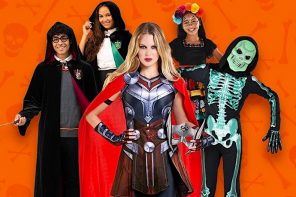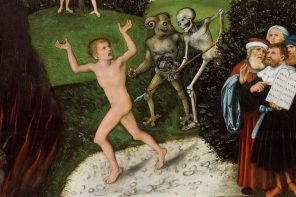It’s October and the telltale signs of Halloween are everywhere; everything from candy to breakfast cereal marketed in orange and black, doors and windows festooned with fake cobwebs and, on a slightly less positive note, evangelicals intensifying their critique of all things macabre and “occultic.”
American evangelicalism has always had a strong sense of evil which it battles in various manifestations—frequently in the form of popular culture. This sense of the presence of and confrontation with evil, however, ramps up during the Halloween season whether the focus is the holiday itself or those minority religions associated with it.
In regards to the season itself, most evangelical churches will offer alternatives to church members, usually called “fall festivals,” since even using the term “Halloween” is frowned upon. At fall festivals kids will more or less do what other kids do on Halloween, though they’ll be costumed as Bible characters in an effort to present it as a distinct alternative.
The rationale here, of course, is that Halloween is evil. Its roots are correctly understood as pagan, but the possibility that not everything that comes from paganism must be evil is ignored; as is that fact that Halloween incorporates a number of elements and influences that have accrued during its journey through various cultures. In truth, some of these elements are Christian, like the feast of the dead that attempted to maintain communion with the saints, both living and deceased. The Roman Catholic Church continues to include this element in its festivities, and thus, as historian Ronald Hutton argues concerning Halloween and Protestant Christianity, “To describe the feast as fundamentally unchristian is therefore either ill-informed or disingenuous.”
The evangelical association of Halloween with contemporary Paganism and Western esotericism and witchcraft gives further pause. Evangelical ministries will frequently address witchcraft during the month of October through radio programs, websites, blogs, and newsletters. Unfortunately, the portrait they paint tends to rehearse various mischaracterizations, including a confusion of witchcraft with Satanism, accusations of ritual sacrifice, evangelical exaggeration of the size and growth of witchcraft, and a misreading of fantasy, fairy tale, and horror depictions of witches as reflecting real-world practice.
Although these disturbing tendencies won’t be disappearing soon, there are some promising changes on the horizon. A small group of evangelical academics, including the noted scholar of new religions Gordon Melton, are calling for a more informed and sympathetic understanding of the broader Western esoteric tradition in the Sacred Tribes evangelical academic journal. Also, new books are being produced that draw upon scholarly historical and ethnographic approaches to the study of forms of paganism, and critique has been brought to popular evangelical books on witchcraft, with evangelicals and pagans even coming together as described in Beyond the Burning Times (Lion, 2009).
Halloween is also a good time to confront monsters. Monster Theory (University of Minnesota Press, 1994), a series of essays edited by Jeffrey Cohen, addresses this question: “Monsters provide a key to understanding the culture that spawned them… What happens when critical theorists take the study of monsters seriously as a means of examining our culture?”
The evangelical subculture is, in many senses, no different than any other in that it creates its own monsters, including paganism and anything related to “the occult.”
One of the tricky things about monsters is that they often come back to haunt their creators, asking some thorny questions in the process. Consider Frankenstein’s monster, stitched together from corpses by his master as a means of empowerment. Dr. Frankenstein is quickly repulsed by his creation for which he wishes to take no responsibility. The rest of Mary Shelley’s story is devoted the disastrous results of Frankenstein’s creation, not only due to the doctor’s decision to create such life, but also in his later refusal to take responsibility for it. In a pivotal moment, the creature asks the doctor why he was created. If our monsters could ask why they were created, what would we tell them? I’m afraid we may not like the answers.




